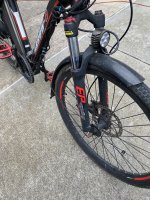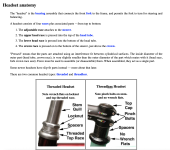My Arrow 9 weighs 75 lbs, has 26 x 1.75" tires. I think the forks are shot and not a very good when new ($140 for new factory replacemnt). How do I tell if it is coil, hydraulic or air? Anyway I want to replace them w/o spending a lot of money since it's an old bike. Just want to improve the ride and handling.
Diameter of the stanchion tubes 32 mm
Center to center width between stanchion tubes 132 mm
Length from bottom of head tube to axle 470 mm
Dropout opening 100 mm

Diameter of the stanchion tubes 32 mm
Center to center width between stanchion tubes 132 mm
Length from bottom of head tube to axle 470 mm
Dropout opening 100 mm

Last edited:






